- History of Maryland in the American Revolution
-
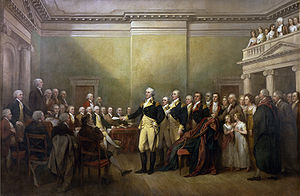 Painting by John Trumbull of George Washington resigning his commission as commander-in-chief of the Continental Army, at the Maryland State House in Annapolis in December 1783, after the end of the Revolutionary War.
Painting by John Trumbull of George Washington resigning his commission as commander-in-chief of the Continental Army, at the Maryland State House in Annapolis in December 1783, after the end of the Revolutionary War.
The Province of Maryland had been a British colony since 1632 and did not at first favor breaking away from Great Britain, but in time became a supporter of the Revolution. Maryland declared independence in 1776, along with the other Thirteen colonies, with Samuel Chase, William Paca, Thomas Stone, and Charles Carroll of Carrollton signing the Declaration of Independence on her behalf.
Although no major Battles of the American Revolutionary War occurred in Maryland, this did not prevent the state's soldiers from distinguishing themselves through their service. General George Washington counted the "Maryland Line" who fought in the Continental Army among his finest soldiers, and Maryland is still known as "The Old Line State" today.
From November 26, 1783 to June 3, 1784, Annapolis briefly served as the capital of the fledgling United States of America, and it was in the Old Senate Chamber of the Maryland State House in Annapolis that George Washington famously resigned his commission as commander in chief of the Continental Army on December 23, 1783. It was also there that the Treaty of Paris, which ended the Revolutionary War, was ratified by Congress on January 14, 1784.
Like other states, Maryland was bitterly divided by the war; many Loyalists refused to join the Revolution, and saw their lands and estates confiscated as a consequence. The Barons Baltimore, who before the war had exercised almost feudal power in Maryland, were among the biggest losers. Almost the entire political elite of the province was overthrown, replaced by an entirely new political class, loyal to a new national political structure.
Contents
Background
Main article: Province of MarylandThe State of Maryland began its life as the Province of Maryland, an English settlement in North America that was founded in 1632 as a proprietary colony of the Lords Baltimore, who wished to create a haven for English Catholics in the New World. The earliest European settlement was at St. Mary's City, Maryland, founded in 1634, little of which remains intact today. Maryland remained under the control of the Lords Baltimore until 1776, when it joined the other twelve of the Thirteen colonies in rebellion against Great Britain and became the U.S. state of Maryland.
Religious strife
Although Maryland was an early pioneer of religious toleration in the British colonies, religious strife among Anglicans, Puritans, Roman Catholics, and Quakers was common in the early years, and Puritan rebels briefly seized control of the province. In 1689, the year following the Glorious Revolution, John Coode led a rebellion, known as the "Protestant Revolution", that expelled the Catholic Lords Baltimore from power, and banned Roman Catholic worship in the Province. However, Coode's government did not endure and in time the newly crowned Protestant King William III installed a crown-appointed governor, Lionel Copley, who governed Maryland until his death in 1694. He was replaced in turn by Francis Nicholson.[1] The Province of Maryland was eventually restored to the control of the Calvert family by George I when Charles Calvert, 5th Baron Baltimore, swore publicly that he was a Protestant and embraced the Anglican faith.
Economy
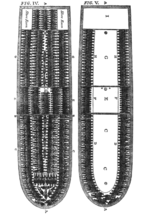 Diagram of a slave ship from the Atlantic slave trade. From an Abstract of Evidence delivered before a select committee of the House of Commons of Great Britain in 1790 and 1791.
Diagram of a slave ship from the Atlantic slave trade. From an Abstract of Evidence delivered before a select committee of the House of Commons of Great Britain in 1790 and 1791. See also: History of slavery in Maryland
See also: History of slavery in MarylandDespite early competition with the colony of Virginia to its south, the Province of Maryland developed along very similar lines to Virginia. Its early settlements and populations centers tended to cluster around the rivers and other waterways that empty into the Chesapeake Bay. Like Virginia, Maryland's economy quickly became centered around the farming of tobacco for sale in Europe. The need for cheap labor to help with the growth of tobacco, and later with the mixed farming economy that developed when tobacco prices collapsed, led to a rapid expansion of indentured servitude and, later, forcible immigration and enslavement of Africans.
The writer Abbe Robin, who travelled through Maryland during the Revolutionary War, described the lifestyle enjoyed by families of wealth and status in the colony:
- "[Maryland houses] are large and spacious habitations, widely separated, composed of a number of buildings and surrounded by plantations extending farther than the eye can reach, cultivated...by unhappy black men whom European avarice brings hither...Their furniture is of the most costly wood, and rarest marbles, enriched by skilful and artistic work. Their elegant and light carriages are drawn by finely bred horses, and driven by richly apparelled slaves."[2]
In the later colonial period, the southern and eastern portions of the Province continued in their tobacco economy, heavily dependent on slave labor, but as the revolution approached, northern and central Maryland increasingly became centers of wheat production. This helped drive the expansion of interior farming towns like Frederick and Maryland's major port city of Baltimore.
Proprietarial rule - The Lords Baltimore
Main article: Calvert family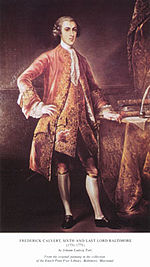 Frederick Calvert, 6th and last Baron Baltimore, "conceited, frivolous, and dissipated".[3]
Frederick Calvert, 6th and last Baron Baltimore, "conceited, frivolous, and dissipated".[3]
In 1751 Charles Calvert, 5th Baron Baltimore died, and his son Frederick Calvert, 6th Baron Baltimore, aged just 20, inherited from his father the title Baron Baltimore and the Proprietary Governorship of the Province of Maryland. Frederick Calvert wielded immense power in Maryland, which was then a colony of the Kingdom of Great Britain, administered directly by the Calverts. Frederick benefited from an income of around £10,000 a month from taxes and rents, a very large sum at the time. In addition he controlled shares in the Bank of England, and an estate at Woodcote Park, in Surrey.[4]
Calvert's inheritance coincided with a period of rising discontent in Maryland, amid growing demands by the legislative assembly for an end to his family's authoritarian rule. Frederick, however, remained aloof from the colony and never set foot in it in his lifetime. Instead, he spent time in England and on the European continent, particularly in Italy. He also lived for a time in Constantinople, but had to leave after being accused of keeping a private harem. Calvert lived a life of leisure, writing verse and regarding the Province of Maryland as little more than a source of revenue. The colony was ruled through governors appointed by Calvert, such as Horatio Sharpe and Robert Eden. Frederick's frequent travels made him difficult to contact and meant that Maryland was largely ruled without him. His personal life was extremely scandalous by the standards of the time, and this contributed to growing unrest in his colony. Count Maximilian Von Lamberg wrote of his Lordship's travels:
- "In 1769 my Lord was travelling with eight women, a physician, and two negroes, which he called his corregidores, who were entrusted with the discipline of his little seraglio. With the aid of his physician he conducted odd experiments on his houris: he fed the plump ones only acid foods and the thin ones milk and broth. He arrived at Vienna with the train I have described; when the chief of police requested him to declare which of the eight ladies was his wife, he replied that he was an Englishman, and that when he was called upon to give an account of his sexual arrangements, if he could not settle the matter with his fists, it was his practice to set out instantly on his travels again."[5]
Frederick died in 1771, by which time relations between Britain and her American colonies were fast deteriorating. In his will, Frederick left his proprietary Palatinate of Maryland to his eldest illegitimate son, Henry Harford, then aged just 13. The colony, perhaps grateful to be rid of Frederick at last, recognized Harford as Calvert's heir. However, the will was challenged by the family of Frederick's sister, Louisa Calvert Browning, who did not recognize Harford's inheritance. Before the case could grind its way through the Court of Chancery, Maryland had become engulfed by the American Revolution and by 1776 was at war with Britain. Henry Harford would ultimately lose almost all his colonial possessions.
Voices for independence
-
This list is incomplete; you can help by expanding it.
Charles Carroll of Carrollton
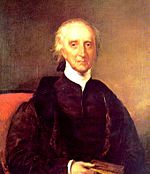 Maryland planter Charles Carroll of Carrollton was the only Roman Catholic to sign the Declaration of Independence.
Maryland planter Charles Carroll of Carrollton was the only Roman Catholic to sign the Declaration of Independence.
One of the early voices for independence in Maryland was the wealthy Roman Catholic planter Charles Carroll of Carrollton. In 1772 he engaged in a debate conducted through anonymous newspaper letters and maintained the right of the colonies to control their own taxation. As a Roman Catholic, he was barred from entering politics, from practicing law, and from voting.
In the early 1770s Carroll appears to have begun to embrace the idea that only violence could break the impasse with Great Britain. According to legend, Carroll and Samuel Chase (who would also later sign the Declaration of Independence on Maryland's behalf) had the following exchange:
- Chase: "We have the better of our opponents; we have completely written them down."
- Carroll: "And do you think that writing will settle the question between us?"
- Chase: "To be sure, what else can we resort to?"
- Carroll: "The bayonet. Our arguments will only raise the feelings of the people to that pitch, when open war will be looked to as the arbiter of the dispute".[6]
It is reputed that the First Amendment to the Constitution was written in appreciation for his financial support during the Revolutionary War by his peers discerning his contributions in such stark contrast to the denial of civic rights due to his Catholicism. However, writing in the Maryland Gazette under the pseudonym "First Citizen," he became a prominent spokesman against the governor's proclamation increasing legal fees to state officers and Protestant clergy. Carroll served on various committees of correspondence.[7]
From 1774 to 1776, Carroll was a member of the Annapolis Convention. He was commissioned with Benjamin Franklin, Samuel Chase and his cousin John Carroll in February 1774 to seek aid from Canada.[7] He was a member of Annapolis' first Committee of Safety in 1775. In early 1776, while not yet a member, the Congress sent him on a mission to Canada. When Maryland decided to support the open revolution, he was elected to the Continental Congress on July 4, 1776, and remained a delegate until 1778. He arrived too late to vote in favor of it, but was able to sign the Declaration of Independence. He was the last living signatory of the Declaration of Independence.
Samuel Chase
Samuel Chase (1741–1811), was a "firebrand" states-righter and revolutionary, and was a signatory to the United States Declaration of Independence as a representative of Maryland. He co-founded Anne Arundel County's Sons of Liberty chapter with his close friend William Paca as well as leading opposition to the 1765 Stamp Act. Later he became an Associate Justice of the United States Supreme Court.
Loyalist opposition
Public opinion in Maryland before the war was bitterly divided; many Marylanders either actively supported the Crown or were unwilling to countenance violence as a means of redress. In 1766, Samuel Chase became embroiled in a war of words with a number of Loyalist members of the Maryland political establishment in Annapolis. In an open letter dated July 18, 1766 Chase attacked Walter Dulany, George Steuart (1700–1784), John Brice (1705–1766), Michael MacNamara and others for publishing an article in the Maryland Gazette Extraordinary of June 19, 1766, in which Chase was accused of being: "a busy, reckless incendiary, a ringleader of mobs, a foul-mouthed and inflaming son of discord and faction, a common disturber of the public tranquility". In his response, Chase accused Steuart and the others of "vanity...pride and arrogance", and of being brought to power by "proprietory influence, court favour, and the wealth and influence of the tools and favourites who infest this city." [8] Such disputes would become increasingly bitter as war approached.
Coming of Revolution
In 1774, committees of correspondence sprung up throughout the colonies, offering support to Boston, Massachusetts, after the British closed the port and increased the occupying military force. Massachusetts had asked for a general meeting or Continental Congress to consider joint action by all the colonies. To forestall any such action, the royal governor of Maryland, Sir Robert Eden prorogued the Maryland colonial assembly on April 19, 1774. This was the last session of the colonial assembly ever held in Maryland.
Annapolis Tea party
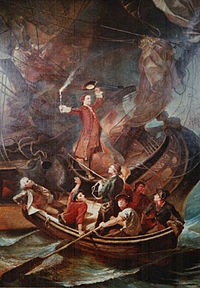 Painting by Francis Blackwell Mayer, 1896, depicting the burning of the Peggy Stewart at the Annapolis Tea Party, October 19, 1774.
Painting by Francis Blackwell Mayer, 1896, depicting the burning of the Peggy Stewart at the Annapolis Tea Party, October 19, 1774.
On October 19, 1774 the Peggy Stewart, a Maryland cargo vessel, was set alight and burned by an angry mob in Annapolis, punishing the ship's captain for contravening the boycott on tea imports and mimicking the events of the more famous Boston Tea Party in December 1773. This event has since become known as the "Annapolis Tea Party".[9]
In May 1774, according to local legend,[10] the Chestertown Tea Party took place in Chestertown, Maryland, during which Maryland patriots boarded the brigantine Geddes in broad daylight and threw its cargo of tea into the Chester River, as a protest against taxes imposed by the British Tea Act. The event is still celebrated to this day each Memorial Day weekend with a festival and historic re-enactment known as the Chestertown Tea Party Festival.[11]
Governor Eden returned to Maryland from England shortly after the Peggy Stewart was burned. On December 30, 1774 he wrote:
- "The spirit of resistance against the Tea Act, or any mode of internal taxation, is as strong and universal here as ever. I firmly believe that they will undergo any hardship sooner than acknowledge a right in the British Parliament in that particular, and will persevere in their non-importation and non-exportation experiments, in spite of every inconvenience that they must consequently be exposed to, and the total loss of their trade."[12]
Despite such protests, and a growing sense that war was inevitable, Maryland still held back from full independence from Great Britain, and gave instructions to that effect to its delegates to the First Continental Congress which met in Philadelphia, Pennsylvania in September 1774.
Assembly of Freemen
 Thomas Johnson, Maryland's first elected governor under its 1776 Constitution.
Thomas Johnson, Maryland's first elected governor under its 1776 Constitution.
During this initial phase of the Revolutionary period, Maryland was governed by the Assembly of Freemen, an Assembly of the state's counties. The first convention lasted four days, from June 22 to June 25, 1774. All sixteen counties then existing were represented by a total of 92 members; Matthew Tilghman was elected chairman.
The eighth session decided that the continuation of an ad-hoc government by the convention was not a good mechanism for all the concerns of the province. A more permanent and structured government was needed. So, on July 3, 1776 they resolved that a new convention be elected that would be responsible for drawing up their first state constitution, one that did not refer to parliament or the king, but would be a government "...of the people only." After they set dates and prepared notices to the counties they adjourned. On August 1, all freemen with property elected delegates for the last convention. The ninth and last convention was also known as the Constitutional Convention of 1776. They drafted a constitution, and when they adjourned on November 11, they would not meet again. The Conventions were replaced by the new state government which the Maryland Constitution of 1776 had established. Thomas Johnson became the state's first elected governor.
Declaration of Independence
Maryland declared independence from Britain in 1776, with Samuel Chase, William Paca, Thomas Stone, and Charles Carroll of Carrollton signing the Declaration of Independence for the colony.
In 1777, all Maryland voters were required to take the Oath of Fidelity and Support. This was an oath swearing allegiance to the state of Maryland and denying allegiance and obedience to Great Britain. As enacted by the Maryland General Assembly in 1777, all persons holding any office of profit or trust, including attorneys at law, and all voters were required to take the oath no later than March 1, 1778.[13][14] It was signed by 3136 residents of Montgomery and Washington counties.[15]
On March 1, 1781 the Articles of Confederation took effect with Maryland's ratification. The articles had initially been submitted to the states on November 17, 1777, but the ratification process dragged on for several years, stalled by an interstate quarrel over claims to uncolonized land in the west. Maryland was the last hold-out; it refused to ratify until Virginia and New York agreed to rescind their claims to lands in what became the Northwest Territory.
Maryland would later accept the United States Constitution more readily, ratifying it on April 28, 1788.
Revolutionary War
Main article: Maryland Line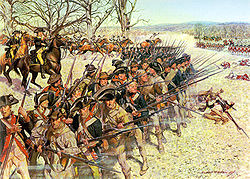 The 1st Maryland Regiment holds the line at the Battle of Guilford Courthouse, March 15, 1781.
The 1st Maryland Regiment holds the line at the Battle of Guilford Courthouse, March 15, 1781.
 Marylander John Hanson (1721–1783) was the first person to serve a full term as President of the Continental Congress under the Articles of Confederation.
Marylander John Hanson (1721–1783) was the first person to serve a full term as President of the Continental Congress under the Articles of Confederation.
Although no major Battles of the American Revolutionary War occurred in Maryland, this did not prevent the state's soldiers from distinguishing themselves through their service. General George Washington was impressed with the Maryland regulars (the "Maryland Line") who fought in the Continental Army and, according to one tradition, this led him to bestow the name "Old Line State" on Maryland.[16][17] Today, the Old Line State is one of Maryland's two official nicknames.
The state also filled other roles during the war. For instance, the Continental Congress met briefly in Baltimore from December 20, 1776 through March 4, 1777. Furthermore, a Marylander, John Hanson, served as President of the Continental Congress from 1781 to 1782. Hanson was the first person to serve a full term as President of the Congress under the Articles of Confederation. From November 26, 1783 to June 3, 1784, Annapolis served as the United States capital and the Confederation Congress met in the Maryland State House. (Annapolis was a candidate to become the new nation's permanent capital before Washington, D.C. was built). It was in the old senate chamber[16] that George Washington famously resigned his commission as commander in chief of the Continental Army on December 23, 1783. It was also there that the Treaty of Paris, which ended the Revolutionary War, was ratified by Congress on January 14, 1784.
Loyalists and the war
Main article: Loyalist (American Revolution) Sir Robert Eden, last colonial Governor of Maryland
Sir Robert Eden, last colonial Governor of Maryland
During the war many Marylanders, such as Benedict Swingate Calvert, illegitimate son of the ruling Calvert family and a Judge of the Land Office, remained Loyal to the British Crown, and suffered the consequences. Calvert found himself on the losing side of the Revolutionary War, which would effectively end his political career. The Annapolis Convention of 1774 to 1776 would see the old Maryland elite overthrown - men like Calvert, Governor Eden and George Steuart were all to lose their political power, and in many cases their land and wealth.
On May 13, 1777 Benedict Swingate Calvert was forced to resign his position as Judge of the Land Office,[18] and, as the conflict grew, he became fearful of his family's safety, writing in late 1777 that his family "has been made so uneasy by these frequent outrages" that he wished to "remove my family and property where I can get protection".[19]
Calvert did not leave Maryland, nor did he involve himself in the fighting, though he did on occasion supply the Continental Army with food and provisions. After the war, he had to pay triple taxes as did other Loyalists, but he was never forced to sign the loyalty oath and his lands and property remained unconfiscated.[20]
African Americans and the war
 British-American Black Loyalist foot soldiers. Slaves were promised freedom by the British in return for military service.
British-American Black Loyalist foot soldiers. Slaves were promised freedom by the British in return for military service.
The principal cause of the American Revolution was liberty, but only on behalf of white men, and certainly not slaves. The British, desperately short of manpower, sought to enlist African American soldiers to fight on behalf of the Crown, promising them liberty in exchange. As a result of the looming crisis in 1775 the Royal Governor of Virginia, Lord Dunmore, issued a proclamation that promised freedom to servants and slaves who were able to bear arms and join his Loyalist Ethiopian Regiment:
...I do require every Person capable of bearing Arms, to resort to His MAJESTY'S STANDARD, or be looked upon as Traitors to His MAJESTY'S Crown and Government, and thereby become liable to the Penalty the Law inflicts upon such Offenses; such as forfeiture of Life, confiscation of Lands, &. &. And I do hereby further declare all indented Servants, Negroes, or others, (appertaining to Rebels,) free that are able and willing to bear Arms, they joining His MAJESTY'S Troops as soon as may be, for the more speedily reducing this Colony to a proper Sense of their Duty, to His MAJESTY'S Crown and Dignity.--- Lord Dunmore's Proclamation, November 7, 1775[21]
About 800 men joined up; some helped rout the Virginia militia at the Battle of Kemp's Landing and fought in the Battle of Great Bridge on the Elizabeth River, wearing the motto "Liberty to Slaves", but this time they were defeated. The remains of their regiment were then involved in the evacuation of Norfolk, after which they served in the Chesapeake area. Unfortunately the camp that they had set up there suffered an outbreak of smallpox and other diseases. This took a heavy toll, putting many of them out of action for some time. The survivors joined other British units and continued to serve throughout the war. Blacks were often the first to come forward to volunteer and a total of 12,000 blacks served with the British from 1775 to 1783. This factor had the effect of forcing the rebels to also offer freedom to those who would serve in the Continental army. Such promises were often reneged upon by both sides.[22]
In general though, the war left the institution of slavery largely unaffected, and the prosperous life of Maryland planters continued.
After the war
 The Official flag of the State of Maryland still retains the arms of the Calvert family, the Barons Baltimore.
The Official flag of the State of Maryland still retains the arms of the Calvert family, the Barons Baltimore.
In 1783, Henry Harford, the last proprietarial governor of Maryland and the illegitimate son of Frederick Calvert, 6th Baron Baltimore attempted to recover his estates in Maryland which had been confiscated during the American Revolution, where he was a witness to George Washington’s resignation of command at Annapolis. He and Governor Eden were invited to stay at the home of Dr. Upton Scott and his nephew, Francis Scott Key. However, he had no success in retrieving his land, despite the fact that Charles Carroll of Carrollton and Samuel Chase argued in his favor. In 1786, the case was decided by the Maryland General Assembly. Although it passed in the House, the Senate unanimously rejected it. In their reasoning for this rejection, the Senate cited Henry's absence during the war, and his father Frederick's alienation of his subjects, as major factors.
Returning to Britain, he claimed compensation through the English courts and was awarded £100,000.
Some trace of the Calvert family's proprietarial rule in Maryland still remains. Frederick County, Maryland, is named after the last Baron Baltimore,[23] and the official flag of the State of Maryland, uniquely among the 50 states, bears witness to their family legacy.
See also
- Annapolis Convention (1774–1776)
- Chestertown Tea Party
- Frederick Calvert, 6th Baron Baltimore
- History of Maryland
- List of delegates to the Maryland Constitutional Convention (1776)
- Oath of Fidelity and Support
- Province of Maryland
Notes
- ^ Events that Changed America Through the Seventeenth Century by John E. Findling, Frank W. Thackeray, pp. 133-134.
- ^ Yentsch, Anne E, p.265, A Chesapeake Family and their Slaves: a Study in Historical Archaeology, Cambridge University Press (1994) Retrieved Jan 2010
- ^ Frederick Calvert at www.epsomandewellhistoryexplorer.org.uk Retrieved Jan 24 2010
- ^ Frederick Calvert at www.aboutfamouspeople.com Retrieved Jan 16 2010
- ^ Lamb, Susan, p.46, Bringing Travel Home to England: Tourism, Gender, and Imaginative Literature in the Eighteenth Century, University of Delaware Press, (2009) Retrieved Jan 24 2010.
- ^ McClanahan, Brion T., p.204, The Politically Incorrect Guide to the Founding Fathers. Retrieved November 2010.
- ^ a b aoc.gov Article on Carroll at www.aoc.gov Retrieved May 7, 2010
- ^ Sanderson, John J, p.67, Biography of the Signers To the Declaration of Independence, Volume 5, published by R W Pomery (1823). Retrieved Jan 21 2010
- ^ Annapolis tea party at www.nytimes.com Retrieved May 9, 2010
- ^ Goodhart, Adam, Tea & Fantasy, published in The American Scholar Retrieved November 2010
- ^ www.chestertownteaparty.com Retrieved May 9, 2010
- ^ Matthews, p.303
- ^ John Thomas Scharf, History of Maryland from the Earliest Period to the Present Day. Published by J. B. Piet, 1879
- ^ Carothers, Bettie S.; Maryland Oaths of Fidelity; ISBN 1585494011
- ^ Daughters of the American Revolution Magazine. Daughters of the American Revolution, Published by R.R. Bowker Co., 1916 v.50 1917 Jan-Jun
- ^ a b Maryland State Archive Online
- ^ Montgomery, Lori (March 14, 2000). "Two-Bit Identity Crisis; Imprint Befuddles the Free—Make That 'Old Line'—State". The Washington Post. gwpapers.virginia.edu. http://gwpapers.virginia.edu/articles/news/mdquarter.html. Retrieved October 7, 2009.
- ^ Yentsch p.269
- ^ Yentsch p.272
- ^ Yentsch p.270
- ^ "Lord Dunmore's Proclamation". Digital History. 2007-10-18. http://www.digitalhistory.uh.edu/learning_history/revolution/dunsmore.cfm. Retrieved 2007-10-18.
- ^ http://www.blackloyalist.com/canadiandigitalcollection/story/revolution/philipsburg.htm
- ^ Room, Adrian, p.27, Dictionary of World Place Names Derived from British Names. Retrieved Jan 26 2010
References
- Yentsch, Anne E, p.55, A Chesapeake Family and their Slaves: a Study in Historical Archaeology, Cambridge University Press (1994) Retrieved Jan 28 2010
- Andrews, Matthew Page, History of Maryland, Doubleday Doran & Co, New York, (1929)
External links
- Frederick Calvert, 6th Lord Baltimore Retrieved Jan 26 2010
- Bibliography of the Continental Army in Maryland compiled by the United States Army Center of Military History
Categories:- History of Maryland
- Maryland in the American Revolution
- History of the Thirteen Colonies
Wikimedia Foundation. 2010.


